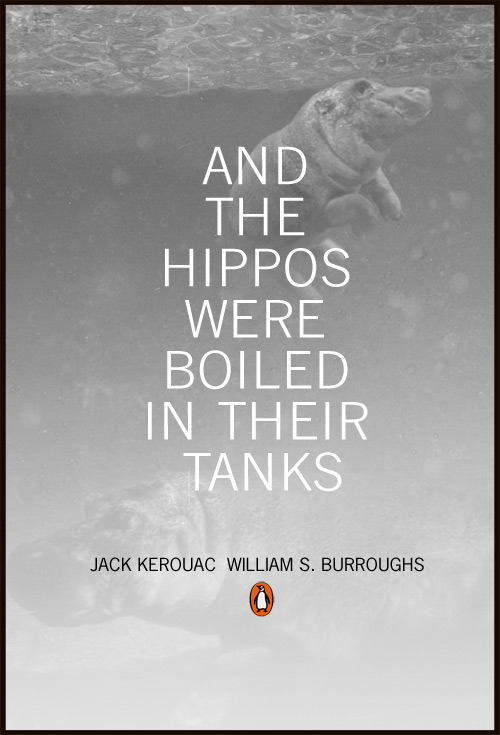Being dead has got to be a drag. Being dead and famous? Still a drag, but at least you impressed yourself into the wax of the world sufficiently to live on, if only in name, for a while longer. Being dead and a famous artist? That’s a whole other tank of hippos. It would seem if you achieve fame in your lifetime as an artist your fate after death is to have every awkward, stinking, aborted creative-effort dragged from the darkness of its banishment, tagged, and shoved under the bright lights. That thing you made whilst naked in the mountains, blindfolded, heartbroken, raving, high on poisonous toad-skin, which you set down in grasshopper blood on the back of a banana leaf… that thing which you awoke three days later to find wedged between a wet deer skull and your car’s front tire… if you were too weak to burn it then when you had the chance, that thing will be found and packaged, and your name will be emblazoned across it, and it will be sold. Yes indeed. It will be sold to someone, or anyone, or everyone with a jangling pile of coins burning a hole in their pocket.
Contact (i)
Search (i)
Annex (i)
Special Projects (i)
Downloads (i)
Shop (i)
Archives (i)
Links (i)
Feeds: rss2 | atom (i)

And the Hippos Were Boiled in Their Tanks


A Little Girl Dreams Of Taking The Veil
Before the combination of Photoshop and, this vast repository of source-materials, the internet began spawning what now certainly amount to billions of wry photo-mashups, there was a predecessor which required of its practitioners expert hand-skills and vision and resourcefulness. I’m talking, of course, about collage, and in the days before pixels, indeed before periodicals positively overflowed with photographic imagery, a fellow, without formal training, by the name of Max Ernst took the form to places previously unimagined.
Around 1919, after having studied philosophy at the University of Bonn and serving in the German army on both the Western and Eastern fronts, Ernst began experimenting with collage. He explains the impetus as follows:
“One day (in 1919), whereas I looked at an illustrated book of objects (umbrellas, watches, tools, clothing, etc) I was surprised to see such different things tight beside the others, things which one does not see together usually, my eyes saw other objects, I wanted to add with the pencil some lines and hatchings between the various objects so that it gives the same images that I see in my dreams.” –Max Ernst.
“It was enough at that time to embellish these catalogue pages, in painting or drawing, and thereby in gently reproducing only that which saw itself in me, a colour, a pencil mark, a landscape foreign to the represented objects, the desert, a tempest, a geological cross-section, a floor, a single straight line signifying the horizon ... thus I obtained a faithful fixed image of my hallucination and transformed into revealing dramas my most secret desires—from what had been before only some banal pages of advertising.” —Max Ernst: Beyond Painting 1948.
The collage-novels which Ernst began creating in 1929, including La Femme 100 têtes (The Hundred Headless Women) and Une Semaine de bonté (A Week of Kindness), undoubtedly represent a pinnacle of the form.
I’d like to share with you some examples from a third collage novel by Ernst, published in 1930, titled, Rêve d’une petite fille qui voulut entrer au Carmel or, A Little Girl Dreams of Taking the Veil, which I am lucky enough to own a copy of. It is the story of a girl who loses her viginity on the day of her first communion and so commits herself to “taking the veil.” The collages, each accompanied by a few short lines, are visualizations of the impious, schizophrenic, and mostly nightmarish dreams she has that night.
The book begins with a 5 page surrealistic sketch by way of introduction. Here is an excerpt:
Academy of Science.
The night will come when the Academy of Science itself will not disdain to cast its gaze on the sewers of the world. The night will come when, covered with all their jewels, the secondary skeletons that one calls scientists will ask themselves this question:
?What do little girls dream of who want to take the veil?
?On that night a violent storm will break against the doors of the academy of science and the water will roar in the pipes.
?The water will remember the shameful year 1930, the year it would have liked to see all the cathedrals of the universe parade in far-too-short dresses. It will remember above all a certain night because…
?On Good Friday night of the shameful year 1930 a child hardly sixteen years old dipperd her two hands in the sewer, pricked her skin and with her blood traced these lines”
?To love the holy father and to dip one’s hands in a sewer, such is happiness for us, children of Mary.
77 collages follow, separated into four sections. Below I’ve reproduced 15 of them complete with accompanying text. Have a look.















The book’s translator’s note has this to say on the collages themselves:
“Each one of these collages uses cuttings often from the most banal of pre-photography illustrated penny novels, and from popular tomes about nature, science, and exoticism. The result may seem to embody our most frequent tragedies, our wriest enslavements, our most terrible solutions. Specificity dissolves in the timeless and the general.” —Dorothea Tanning.
The introduction to Max Ernst: A Retrospective adds the following:
“Max Ernst’s collages, for all their strangeness, strive for overall coherence and technical plausibility. This ‘plausible’ imagery, unlike the papiers colles of Picasso and Georges Braque, depends on an expurgation of the visible difference between artist’s hand and non-artistic quotation. The joins and overlappings had to be concealed from the viewer. This is why Ernst frequently published his composite imagery only in printed form, in photographic reproduction or in versions later touched up with watercolour. Thanks to these tactics of concealment he succeeded in presenting collage as that which he thought it should be: a completely developed and autonomous system in which the origin of the separate elements is submerged in the final, total image. He was out to produce irritating imagery in which, as in the perfect crime, every clue to its identity had been erased.” — Werner Spies.
To me there is a gravitas to etchings and wood engravings, a sort of official-ness, which is unshakeable. Perhaps it is simply the obvious effort involved in their creation or their historic connection with inherently valuable printed matter (be it newspaper or book) which lends the form these overtones. In any case, I think it is exactly this implied gravitas playing against Ernst’s strange, poetic, feverish, and funny subject matter, which creates the oddly arresting magnetism they still manage to exert almost 80 years later. I can only wonder at the effect they had on viewers in the 30’s… Some mixture of giggle and shiver I would imagine.
Anyhow, hope you enjoyed these.
For more on Ernst’s collage-novels see:
Une Semaine de Bonté: A Surrealistic Novel in Collage on google books.
Une Semaine de Bonté at La Boîte A Images.
A Week of Kindness at Giornale Nuovo.
La femme 100 têtes at Koninklijke Bibliotheek.
Werner Spies’ piece at Artchive.com.
The enduring significance of the work of Max Ernst By Stuart Nolan.
Max Ernst’s Adventures in Collage from The New York Times.
Kindness Week a film by Ernst based on his collage.
Ernst related videos at Tiosam.com
-
Note: This post is in a series of reworkings of old posts which date from before the redesign of The Nonist. The text has been reworked and added to considerably, the amount of images has been doubled, and the links are all new. I will be periodically adding these reworkings into the flow of new content in an effort to eventually remove all the old pages from circulation.
hide full text

Histoire Naturelle des Indes
The Histoire Naturelle des Indes, created sometime in the 1590’s, is one of the earliest illustrated records of European contact with the America. Also know it by its informal title The Drake Manuscript it was donated to the the Pierpont Morgan Library in 1983, who after many years of study graciously produced a full color facsimile. I happen to have said facsimile, which was published in 1996, right here in front of me. Shall we take a gander?
First a few words on the manuscript’s origins and possibly misleading title.
The Drake Manuscript is named for Sir Francis Drake, the famed English privateer, navigator, slave trader, politician, and pirate of the Elizabethan era, whose travels it is thought to illustrate. Though Drake was himself something of an artist ⊕, the images in Histoire Naturelle des Indes were not created by his hand. Nothing of his artwork survives as it turns out.
Truth be told there is no conclusive evidence to suggest that Drake had anything to do with the manuscript, let alone that it ought to be informally named after him. Such are the gears of history- grinding the anonymous down to invisibility and raising the famed higher… for a while at least.
The best guess as to the manuscripts origins are something along these lines-
The naive drawings ⊕ show signs of being created by several separate hands. Context reveals that these were likely the hands of Huguenots. Drake is known to have employed not only Huguenots on his voyages but artists as well. A “considerable number” of the images correspond to ports of call familiar to Drake, in some cases associated directly with his voyages, and Drake is mentioned by name, twice, in the manuscript itself. Hence, with a nice pile of circumstantial evidence to stand on, and no other clues, we have The Drake Manuscript.
Anyhow, whether this is simply an instance of a famous name capturing otherwise anonymous historical debris with its considerable gravitational pull ⊕ or simply an instance of fine deduction on the part of historians doesn’t matter much. What matters are the 199 fascinating images and accompanying captions.
Taken as a whole the images are an interesting mixture. The drawings of plants and animals are presented in a sort of cold practical manner, removed from their natural surroundings, with captions that read almost like a sales catalog, listing the virtues and drawbacks of each. ⊕ The drawings of the indigenous peoples themselves on the other hand are altogether warmer and seem to serve no greater purpose than curiosity.
The styles of the images are an interesting mixture as well-
Quote, “Some drawings are well rendered, others mere daubs, but most have a kind of buoyantly piquant vision of their subjects. Some are true to life, some–particularly the fishes with doglike snouts and ears–arise from an almost medieval fancy, and some may reflect a knowledge of printed sources.” - Verlyn Klinkenborg.
I’ve reproduced a group of the images below for your scrutiny. Some were chosen because I particularly liked the drawing, some because I was amused by the caption, and some because the ghost of Drake, boarding the deck of my apartment and holding me at sword-point, compelled me to. Have a look for yourself.

PETVN
(Tobacco)
“A special herb which the Indians use for food as well as an extremely beneficial medicine; when they are sick, they breathe in the smoke by mouth with a straw; soon the ill humour escapes by vomiting. They often pulverize it and, putting it in their noses, it distills several drops of water from the brain to discharge it. It is also found very helpful for toothache…”

MANTTE
(Manta Ray)
“This fish is very large and no less vicious. When the negroes dive in the sea for pearls it jumps on them to make them drown and afterward eats them.”
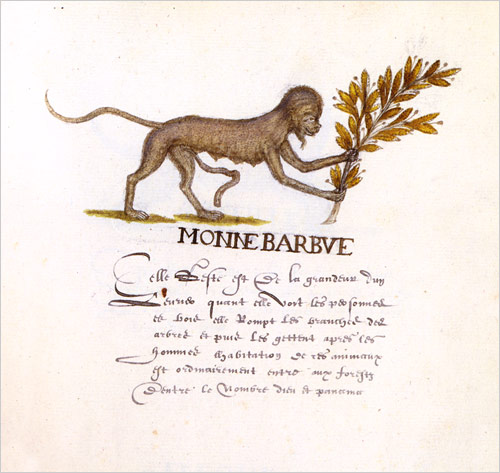
MONNE BARBVE
(Bearded Mona)
“This animal is the size of a greyhound. When it sees people in the woods it breaks off branches and throws them at them…”

MOVQITES
(Mosquito)
“These are small flies which are so small one cannot see them, they are very dangerous. When there is no wind and the weather is calm, they come in droves attacking people, stinging them in such a manner that one would take them for lepers…”

HINDIANE
(Woman of the Indies)
“This woman chases the flies away with a little bell hanging from a tree branch, afraid that when they bite their children, they will cry, for seeing their children cry makes them sad, having visions that at that time the devil is in their body…”

MENSENILLE
(Manchineel Tree)
“A very piusonous tree, so that if a person looks up to it, he will be blinded for three hours afterwards. The Indians hide their arrows in this tree when they are at war in order to make them poisonous.”

CENT PIERNE
(Centipede)
“A very poisonous beast. It feeds in places where there is wine and vinegar. It only moves around at night. A person who has been bitten by this animal lives only for twenty-four hours afterwards. It finds the Indians in their beds in order to kill them.”

TIGRE FERMILLIERE
(Tiger and Anteater)
“Savage beast. However, whenever this small animal called anteater encounters a tiger looking for prey it turns on its back and throws itself on the tiger’s neck and pierces its throat with its snout and claws and does not release him until he is dead on that spot.”


FEU
(Island called “Fougue” or Fire Island)
“During the day one always sees smoke on top and when the sun has set and night has come, one likewise sees a great fiery blaze because on the island and on the summit, the earth produces sulfur and there is thunder and lightening which cause the continuous fire…”

HINDE DE LA TRENITE
(Indian of Trinidad)
“Tha manner of catching parrots is this: if they are large, they make a trap with string attached to it. In this trap they put a parrot with his feet tied and next to him a small animal called a catille which plucks him. When the parrot cries and the other parrots, hearing his voice, come to his rescue, freely joining him in the trap, the Indian seeing this pulls the string and the parrots are instantly trapped.”

PIOVCHE DE MER
“This is as valuable as a louse.”

CIFRE
(Monkey)
“This is a very agile beast. The Indians cannot tame it or feed it for they die of grief and do not eat in captivity. They have a face like a human and are very mischievous and rebellious and throw themselves against people mainly in their faces and eyes.”

PERIQITE LEGERE
(Sloth)
“The nature of this animal is so to climb with its belly uppermost and, climbing this way, it moves faster than a man could on foot. The skin of this animal is very excellent for people suffering from falling sickness [epilepsy]. The head of the afflicted is covered with it then one realizes how effective the skin is.”

HINDES DE IHONA
(Indiands of Ihona)
“When the Indians have defeated their enemies, they make them lie down on the ground, then pound on them, and after that, give them a blow on the head with their sword. When the blood starts flowing, they hold it back promptly, thinking that by this means the body will make a better roast for a solemn feast, calling this a deed of prowess.”

PORC DE MONTENNE
(Mountain Pig)
“This animal is called a mountain pig because it lives in the mountains. It is adroit at climbing. It has a navel on its back. “


AVILANNES BLANCHES GOMITES
(White Physic Nut)
“They may well be called white nuts… They don’t make one vomit at all.” This is as opposed to the black Physic Nut which has quite different effects. “When a person has eaten them, he will throw out everything in his body above and below.” The Indians evidently ate the black nuts when they felt they’d been poisoned as a way of expelling the poison from the mouth and from “below.”

TIBERON
(Shark)
“This fish is very viscious in the sea so that when a sailor throws himself into the water for some reason this fish turns on his back and tears out a leg or an arm and eats it.”
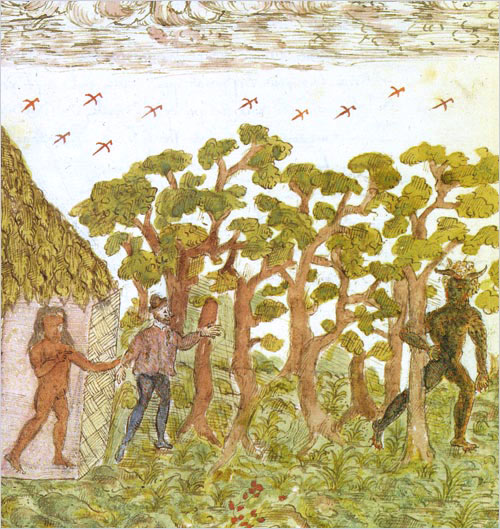
COMES LES YNDIENS ONT ORDINAIRM[ENT] DES JLLUSIONS DU MALING ESPRIT
(How the Indians Usually Have Visions of the Evil Spirit)
“The Indians are much tormented at night by visions of the Evil Spirit whom they call in their language “Athoua.” They do not dare leave their houses at night–only when light has come–and this is because they have no belief nor education and do not worship anything…”
I find these fascinating, and believe me when I say I had trouble choosing from the 199 plates reproduced in the excellent facsimile.
Concerning the images themselves it amazes me to look at them in the artistic context of their time, because though I undoubtedly find them beautiful, when I remind myself that they were created in the 1590’s, and that at that same moment El Greco, Rubens, and Caravaggio were all active… well it’s surprising. Thought of in those terms it’s a wonder these weren’t made by the “Indians” themselves.
I think today, with television and advertising and graphic design having made the shared “visual language” so pervasive, we have a tendency to regard varying levels of visual sophistication simply as styles which homogeneously blanket entire eras, permeating everything from high art to life’s daily banalities. It may be true, to some degree, as far back as the 19th century, but images like those in the Drake Manuscript are, for me, a useful reminder that if you travel further back, our conceptions begin to break down and become little more than assumptions, based on the retrofitted categorizations art historians have coined for us.
The captions fascinate and amuse me for a similar reason. There is something comical to me about contemporaries of Shakespeare, Giordano Bruno, Cervantes, and Galileo ⊕ traveling to these “savage” lands, filled with a blustery and inalienable sense of their own superiority over the ignorant inhabitants, who upon arrival and lengthy inspection proceed to relay information as goofy and superstitious and folkloric ⊕ as their dark-age ancestors might have believed.
Of course, as not to fall into the same trap of egoistic presumption, and lest snide ephemera hunters of the 3000’s stumble upon this blog (attributing it, of course, to Markos Moulitsas or Xeni Jardin whilst my anonymous bones decay in quietude) and scoff at the wrong-mindedness of it all, I’ll shut my mouth right there.
-
For a bit more on the manuscript see-
Histoire naturelle des Indes on Google books.
This pdf from the National Humanities Center.
-
I’ll only say this in closing, I enjoyed these and I hope you did as well.
hide full text

Mechanismo
Or: praise of futures past
A few weeks ago I picked up a book in the bargain bin at Strand titled Mechanismo. When the guy ringing me up at the checkout counter came upon it in my stack, he stopped, flipped through it quickly and somewhat sheepishly, and alerted a buddy standing a few registers down. They admired it together. I remember thinking, “Well, guess that one is Nonist worthy.” ⊕ The book, published in 1978, is essentially a collection of essays by the venerable Harry Harrison on all things science-fictional. What makes the book standout, however, is the bounty of 70’s era sci-fi illustrations contained within, and it’s some of these that I’d like to share with you.


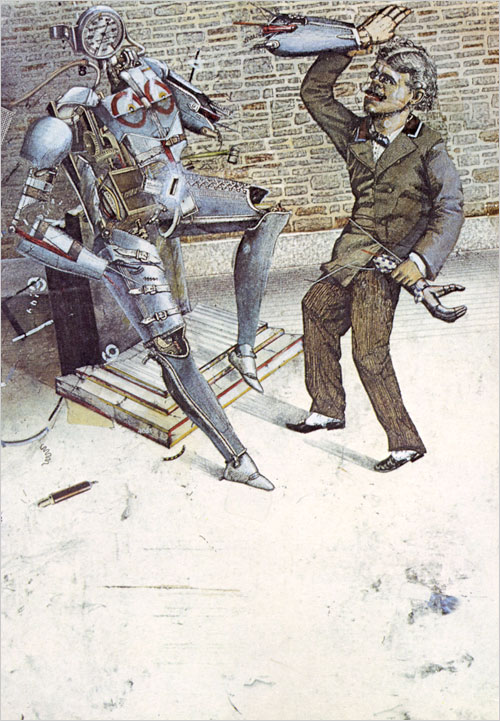
The Dynamometer, originally created by Alfred Jarry in his novel Supermale, as envisioned by artist Russel Mills.



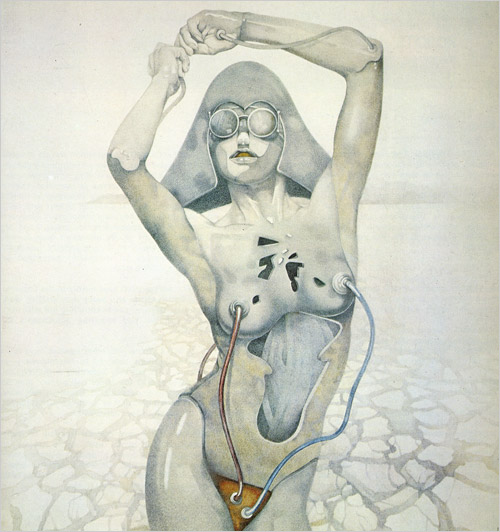

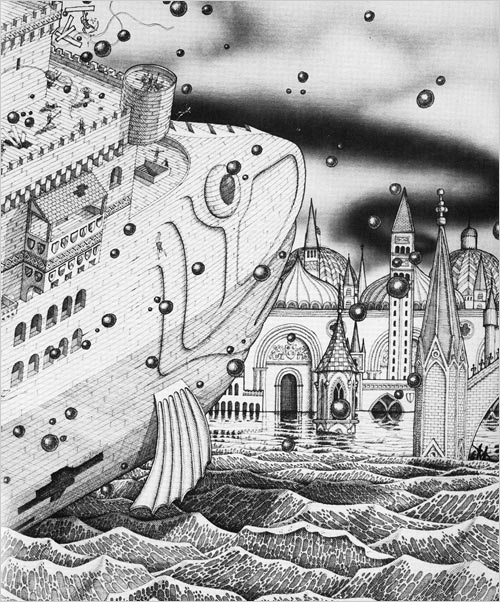
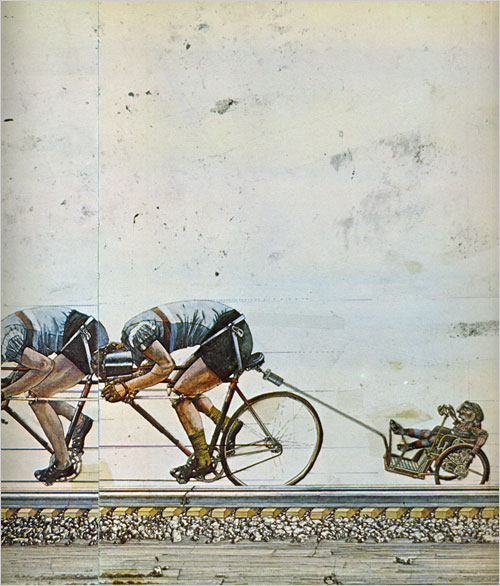
And let’s not forget that enigmatic architectural face, or “Cybertectural Animot,” which began the post. It is a detail of a piece depicting walking cities by artist Mike Wilkes, and you can click here to see the full image.
-
You might look at these images of the future and find them stylistically dated, and they are 30 years old at this point, literally images of futures past, so I wouldn’t argue with you. I do think, however, that in a very palpable way these images, and images like them from the late 50’s all the way through the early 80’s, represent something which, in sci-fi’s drive toward the future, and possibly more to the point its drive toward “respectability,” the marketers of the genre have let slip away. That thing being Style.
A critique of the current face of science fiction and fantasy, as embodied in its book covers, is a voyage I plan to undertake, enthusiastically, in a future post. So I’ll just leave it at that for now.
In the meantime I hope you enjoyed these at least as much as those Strand cashiers seemed to, and I hope the sensation of feeling nostalgia for decades old visions of the future which have not nor may ever arrive is not to off-putting. Likewise I hope deeper reflection on the oddity of such a feeling does not leave any ugly bruises on your brain.
Until next time…
hide full text


In 1846 Dr. Andrew Comstock, proprietor of one of the oldest commercial language schools in America, called Dr. Comstock’s Vocal Gymnasium and Polyglot Institute, published his Treatise on Phonology. In 2008 I came across it on google books and, reading its simultaneously bitchy and braggadocios full title– A Treatise on Phonology: Comprising a Prefect Alphabet for the English Language; a Specimen Exhibition of the Absurdities of Our Present System of Orthography, I laughed. Reason enough to whip-up a quick post, so far as I’m concerned.
Well, as you might expect, it turns out that the “perfect alphabet” of the title, which the book sets forth as remedy to the “absurdities” of English, also mentioned in the title, is a phonetic alphabet created by Comstock himself.
Quote: “It is generally admitted that our orthography is more complicated than that of any other language. Various attempts have been made by different individuals to simplify it. The author of this treatise, however, proposes not only to simplify it, but to perfect it.”
Before you go off half-cocked mocking and scoffing Dr. Comstock for pomposity, first remind yourself that he invented his more-perfect-than-English alphabet at a time when religious and philosophical outlooks on causality were giving way to scientific ones, which is to say that the prevailing feeling among the educated was that with some properly focussed brain-power any “problem” could be “solved” by scientific means, that this was the age of the elocution movement, and that there had already been, before he ever set overconfident pen to paper, at least a century’s worth of individual efforts to overhaul English. Benjamin Franklin had made his own attempt as early as the 1760’s after all, and you wouldn’t mock old Ben now would you?
Then there is the little matter which, being so far removed from grammar school, you have likely forgotten- English is a weird and knotty frankensteinian creature.
(After many paragraphs to back up the statement) Comstock puts it this way: “Our language is hedged about with difficulties which can hardly be overcome even by years of laborious study. The young student is obliged to waste much precious time in learning to spell and read our crooked words, and the adult foreigner is appalled by obstacles which seem to be insurmountable. Now, all these difficulties would be entirely removed by the adoption of a perfect alphabet — an alphabet which should represent language phonetically.”
Of course, now that you’ve reminded yourself of these things, you can go ahead and laugh anyway.
I personally find myself amused, not so much by the seemingly quixotic quest to just put on the brakes and change the course of a living language, but by the obvious galled irritation Dr. Comstock felt.
Quote: “...the 38 elementary sounds of the English language are represented in 336 different ways, which may be considered equivalent to three hundred and thirty-six different letters! Is it possible to conceive of a more complicated, absurd, unphilosophical, and barbarous system of orthography?”
Barbarous?! Hahaha.
We, all of us, find aspects of our own vocations thorny and annoying. The convolutions and abstruseness and wrong-mindedness which seem to permeate every human endeavor formulated or informed by any consciousness other than our own can exasperate; but imagine if your vocation was language! Imagine if it were English itself that stuck in your craw. Talk about fighting windmills.
Anyhow, if you are interested, Comstock’s phonetic alphabet broke down essentially as follows-
Quote: “This Alphabet comprises all the letters of the Phonetio Alphabet for the English Language, with additional ones to represent sounds peculiar to foreign languages. Comstock’s Phonetic Alphabet is the common, or Boman alphabet, not only so extended, by the addition of new letters, that there is a character for every articulate sound, but so improved by the introduction of signs for the various modifications of the voice in speech, that there is a character for every accent, inflection, intonation, etc. Hence it must be considered a perfect alphabet.”
Including all 44 characters and 16 tone marks Comstock’s perfect alphabet looked like this-

If you were enthusiastic about the alphabet and wanted to set about immediately hand-writing a letter to your dear old mother, or your betrothed in Niagara Falls, you could refer to this chart as a guide-
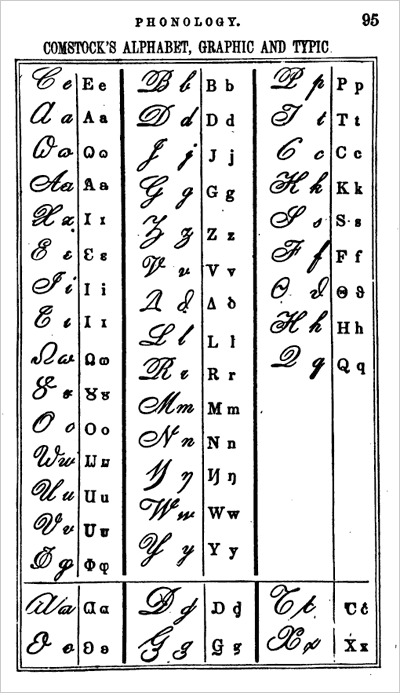
Meanwhile if you wanted to set about teaching the gents down at the club or the fellows at the beer garden this new method, some charts depicting mouth articulations, grouped by phoneme, would be helpful. Luckily Comstock furnished these, saying-
Quote: “An accurate knowledge of the positions which the organs of articulation should assume in the formation of the several elements of vocal language, is very important to those who would speak with ease and elegance. To aid the reader still further in the acquisition of this knowledge, he is furnished with the various postures of the mouth, required in uttering the elements energetically, and singly.”

“The pupil should exercise his organs of speech, in the most forcible manner, every day, on all the elements. The vowels should be exploded from the throat, both interrogatively and affirmatively, in every range of pitch.”
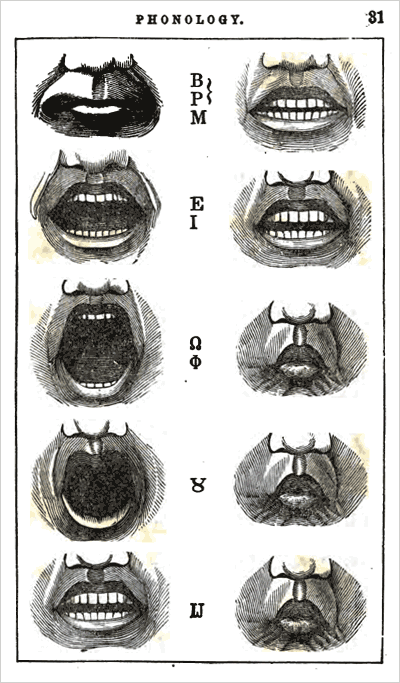
Certainly, even armed with logic and charts and enthusiasm, there would be some doubters. To them, leaving aside stability and ease of use, you could quote a few of the many benefits Comstock himself lists, like, say-
3. It would enable one to spell and read in one-twentieth the time required by the present absurd and barbarous orthography.
4. It would render the teaching and the learning of the English language, which, by the old theory, are extremely irksome, highly interesting.
7. It would interdict provincialisms; because, according to this theory, all words are spelled as they are pronounced, and, consequently, pronounced as they are spelled, every graphic word being a perfect Daguerreotype of the vocal word which it represents.
10. As, in phonetic spelling, most of the words have fewer letters than are employed in our present orthography, this alphabet would enable a writer to put more matter upon the same page.
13. The adoption of this alphabet would not only be the means of greatly advancing the cause of science and literature, but would be invaluable to the missionary in disseminating a knowledge of the gospel among the heathen.
How can you argue with that? Comstock certainly couldn’t see any way.
Quote: “The Author feels confident that no one who peruses this treatise understandingly, will desire to cling any longer to the old system of orthography, unless he prefers chaos to order, —discord to harmony, —darkness to light. Hence, he sends forth his Alphabet to the world with the most sanguine expectation that it will meet the entire approbation of the public, and be speedily adopted.”
I might wonder weather, having seen his countrymen choose chaos, discord, and darkness over his perfect alternative, he died sanguine as well… were it not for the obvious linguistic contradiction of it.
Anyhow, hindsight being smug and sadistic as it is, we know his grandiloquent claims and aims came to naught. We know also that the scores of other contrived alphabets which came before and after his met similar fates. I don’t believe there has ever been a constructed script, in the history of the world, which has supplanted a “naturally” evolved predecessor by dint of logic and force of will.
Perhaps it’s the fact that, as in Comstock’s case, a switch might benefit 3rd graders and immigrants but would effectively render the entire adult population of the country illiterate in the bargain?
Perhaps it’s because, ever since learning as ankle-biters what the characters MOMMY added up to, our alphabet is so intertwined with our language, and hence, our thoughts, our minds, our being, that we would never and could never willingly replace it?
Perhaps it’s because language is a vibrant and living and evolving thing which has never, not even in or present “barbarous” orthography, been truly tamed and finally codified?
Or perhaps it’s just that the overwhelming majority of us are not elocution teachers, or linguists, or grammarians, and so the quirks of English just simply do not stick in our craws enough to warrant, in any of our minds, a “solution?”
Hell, I don’t know.
Though his perfect alphabet is all but forgotten, I would like to thank Dr. Comstock, none the less, for not only affording me a chuckle (which I suppose I ought to be offering apologies for rather than thanks) but more importantly for occasioning circumstances in which the letters “Phonemenon” could be put together, in that exact order, and be something other than a misspelling.
So in his honor, finally, let me offer the following, may it live on in the minds and mouths of we who have choosen chaos, discord, and darkness:
Pho·nem·e·non [fo-neem-uh-non]
noun. plural: phonemena.
1. A vocalization, or sound made with the mouth, that is perceptible by the senses.
2. A remarkable or outstanding utterance.
Hope you enjoyed.
hide full text

